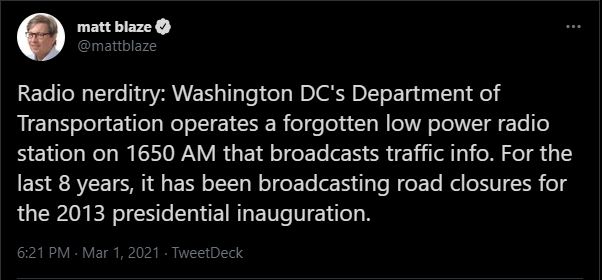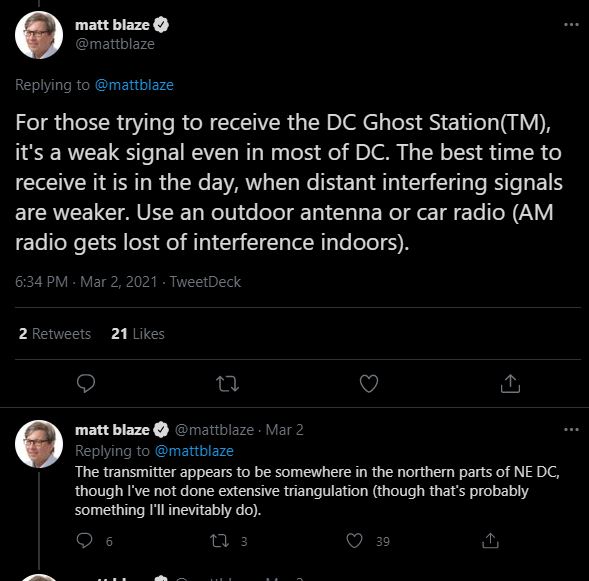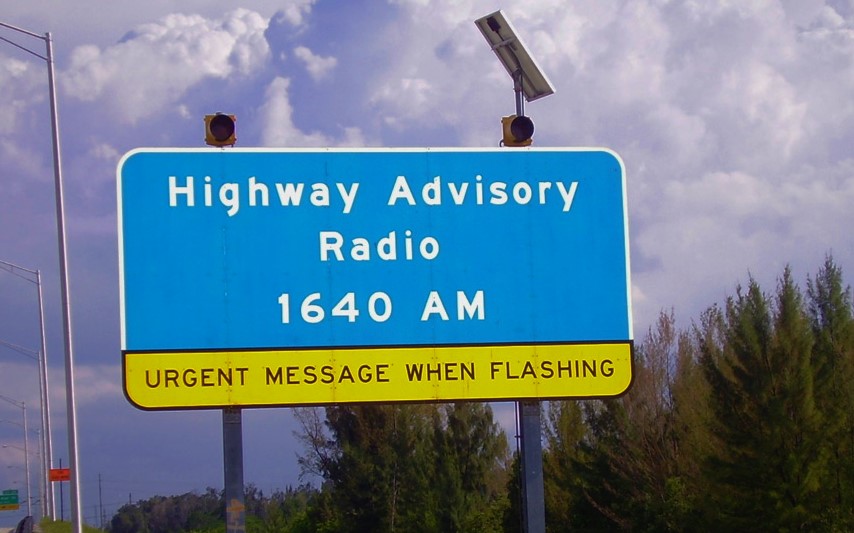Sometimes we radio enthusiasts discover odd things on the air.
We’re listeners and we notice things.
A few days ago our friendy, Matt Blaze, tweeted this:
 Yep, for eight years a DDOT TIS (Traffic Information System) transmitter has been broadcasting the same repeating message and few have noticed.
Yep, for eight years a DDOT TIS (Traffic Information System) transmitter has been broadcasting the same repeating message and few have noticed.
 You can read Matt’s whole Twitter chain here.
You can read Matt’s whole Twitter chain here.
Matt has also kindly shared an audio recording of this transmitter. He notes that the reception “was weak but readable” from his home:
What’s more, Matt’s tweet was picked up by The Drive and turned into a post, thus exposing our radio geekery to the populos at large. Many thanks to the numerous SWLing Post readers who shared a link to the article.
I have to assume someone from the DDOT was paying attention too because Matt posted that as of March 3rd, it appears the transmitter has been taken off the air:
This reminded me of another transmitter stuck in time that I thought David Goren once mentioned. I checked with him and he confirmed:
Yes, there’s a transmitter somewhere on MW in NYC that has been broadcasting: “this is a functional test of the text-to-speech capability of the [VR or BR 2000] software package”. They’ve probably been on at least 10 years.
Many thanks to David for sharing the following recording:
Have you ever heard a forgotten transmitter? Please comment with details!



I have heard Traffic information Station on 1640 khz Reagan Airport.WRBM 347.
Here’s TIS story with some intrigue. Decades ago I was wondering about the exact location of a TIS transmitter operated by the Pennsylvania Turnpike Commission on 530 KHz on the Northeast Extension (PA 476) — not far north of Kulpsville where the annual SWLFest was held.
Eventually it dawned on me that instead of complicated mediumwave DF triangulation, I might be able to locate the TIS station by simply tuning my car radio to the the station’s first harmonic frequency of 1060 KHz, which local powerhouse KYW occupies, and driving up the PA Turnpike. My theory was that if I was right next to the TIS transmitter, its first harmonic might briefly overwhelm KYW as I drove by.
Sure enough, the next time I drove north on PA 476 while monitoring KYW 1060, I heard a brief moment of QRM and quickly pulled off the highway. After exiting my vehicle I walked back about 100 yards to find a oddly-located wooden utility pole about 30 feet off the road. It was topped with a vertical antenna. An overhead AC powerline and telephone line ran to the pole, and a breadbox-sized white metal box was mounted at chest height. I’d found it!
There was no padlock securing the box; just a recessed 7/16″ hex head bolt that I knew could be loosened with a telco ‘can wrench’. So during my next nighttime trip north I brought my can wrench, flashlight, notepad, and my ‘butt set’ test telephone. Finding the transmitter again was easy thanks to its telltale first harmonic, and I pulled over and walked back to its ‘tower’.
The phone line terminals were covered by an easily opened old-style rubbery housing screwed to the utility pole, and were greeted with the test clips of my butt set. Dial Tone! Calling a special telco ANAC number yielded the TIS station’s remote access number, which I jotted down (this was in the pre-Caller ID days.) The main box was easily opened with my telco ‘can wrench’.
Inside was two smaller metal metal boxes, one containing the AM transmitter and the other a digital ‘tape loop’ recorder/player. Also inside was the operation manual and maintenance log, which showed it had been years since the last FCC-required inspection. More interesting was the manual’s description of how the remote access feature allowed calling in by phone to record a message for broadcasts.
Amazingly, the remote DTMF access code was a mere 2 digits(!) followed by the # tone, and it was hard-wired via a diode matrix so I knew the operator couldn’t easily change it. The code was conveniently handwritten inside the manual, so I jotted it down, too. I then had all the info I needed, so I put everything back in place and drove away, amazed at what I’d discovered and the possibilities now at hand.
One calm sunny day not long after, when new traffic information seemed unlikely (that TIS station’s message rarely changed anyway) I called the remote access number and recorded some musical audio onto the digital tape loop.
An hour later while driving upstate on PA 476 and monitoring 530 KHz on my car radio, I heard a song by Frank Zappa, “Bobby Brown Goes Down”, which had been a #1 hit in Europe but which got no airplay in the U.S. due to FCC profanity regulations. It was long past due for that FCC injustice to be corrected.
About week later on my return trip from my upstate visit, that same song was still being broadcast on that TIS station at 530 KHz. Apparently nobody at the Pennsylvania Turnpike Commission noticed or got any complaints. But that week of continuous broadcasts of Frank Zappa’s “Bobby Brown Goes Down” racked up about 10,000 potential FCC profanity and station ID violations — a probable record for any TIS station, or any other broadcast station for that matter. Justice had been served.
A couple of weeks later I came back and heard the default TIS message with Station ID playing on 530 KHz. Whether that was a routine update or someone noticed and fixed the content, I’ll never know. But this exercise proved how easily the broadcast format of a TIS station could be remotely changed, if one were to know such things..
Literally LOL! 🙂 What a wonderful example of a hack in the original (well, 60-80s) ethical meaning of the word – half prank, half demonstration of an exploit plus 50% holding up a mirror to someone = 150% good.
1. Regarding the DoT TIS, confirmation that once a Government program is initiated, it is hard to stop.
2. Thinking about the slow demise of unattended non-directional beacons (NDB), yagotta wonder if some of them haven’t gone silent from natural causes.
3. Over 50 years ago, some broadcasters were already experimenting with automated content. I remember calling a station in suburban Springfield, MA to tell them the needle on the turntable had been circling the gutter groove for well over a half an hour.
I suppose today’s analogy is broken Internet links.
Bob Colegrove
I think it was a “lost” or “forgotten” transmitter, which might be a necessary distinction to all the transmitters that some of us want to get lost or forgotten for one reason or another because they’re deliberately stuck in time. 🙂
Great humorous story, but these stations are still alive and well here in NJ. I use a 31 ‘vertical and a Yaesu FRG-100 to listen from 1600 – 1710 kHz to look for these stations. Early mornings around dawn are the best times to listen for these low-powered stations.
This is hilarious! There is one of these transmitters out where I live in California, owned and operated by the City of San Ramon. It repeatedly broadcasts the same notice that the station is only used during emergencies. I hate to break it to them, but no it isn’t. In the last five years with wild fire threats, power shut downs and (get this) road closures (in the city of San Ramon) the same notice just plays on and on. I don’t think the city even realizes its on.
I will admit that I’m completely baffled why this story was of interest outside our community. But I was also surprised when the Internet took off, so what do I know.
Check out Information Station Specialists’ website for lots of info on these stations. The owner, Bill, is a great guy. https://www.theradiosource.com/
With his assistance I wrote about these stations in Monitoring Times many years ago.
https://www.theradiosource.com/downloads/2014-spectrum-monitor-article.pdf
Since the transmitter is now silent, has the sign in the photo above been removed?
Thank goodness that this wasn’t noticed during the most recent administration. There would have been an entire wing of Space Force troops out knocking down doors to find this relic of the Obama administration.
That’s funny… My sister actually told me about this story just yesterday, but makes you contemplate, if you wanted to take-over a TIS station with your own programming, just how long could you get away with it? Hmmmmmmmmmm??? Sounds like that it stood the test of time. Gee… Can’t even get commercial stations to be this reliable.
Well, low power Part 15 AM transmitters are legal for anyone to purchase and use in the US. Max output is 100 mW which won’t get you far, and the antenna is limited to about 3 meters in length which includes the feedline.
I used to set up these transmitters at my last job when we had flu clinics and needed to let the public know the details while they were in the site’s parking lot.
Real estate agents used “Talking House” transmitters years ago so potential buyers could listen to the sales pitch on a particular house for sale by tuning the car radio to a particular frequency. EBay has them occasionally for auction.
You brought back a memory. At age 12, I received a Heathkit like the one in the YT vid below. And that kit had the capability of building the low power AM Transmitter described. Always fun to “broadcast” over the various transistor radios in the house. That kit lead to my lifelong interest in electronics and radio.
A friend of mine got one of these as a gift :https://toytales.ca/caravelle-radio-transmitter-and-receiver-remco-1962/ We had lots of fun with it and got better range by connecting it to a long wire antenna strung across my mother’s clothes line.
Some ops use an RF signal generator to broadcast music over the air or their home radios. That works too.